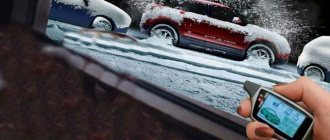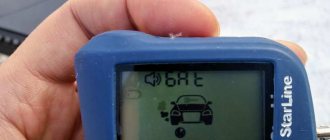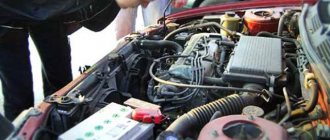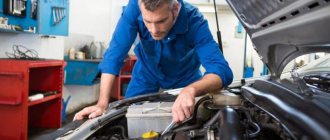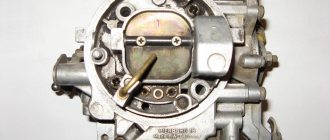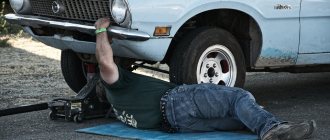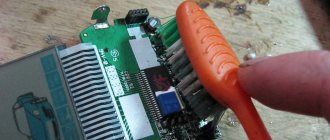Shaking and vibration in a car is dangerous. If you encounter this on the road, it's best to stop and investigate the possible problem. Today we will tell you about all the reasons that can cause your car to vibrate or shake on the road.
Of course, it will be easier to find the cause if you understand the nature of the shaking. If the car shakes in a certain gear, then you should check the transmission. If it starts to shake at a certain rpm level, have the engine checked. But often the problem is different.
We will provide you with a checklist of sorts so that you can easily find the problem and understand whether it is safe to continue driving.
Type of shaking and vibration
To better understand what's going on with your car, you need to check the type of vibration. If your car shakes while driving, there may be a problem with the suspension or wheels. If it vibrates when you start the engine, you need to check the engine - for example, one of the cylinders may not be firing. If your car shakes when braking, it's obvious that you need to check your brake rotors and pads.
Let's start our checklist by going into more detail about what can actually cause your car to vibrate under different conditions.
Tire problems
The first reason for shaking in the car is possible problems with the tires. They may have too low or too high pressure. This will cause discomfort when driving on a bad road. A flat tire will cause severe vibration and loss of control. But even if the tire is not flat, but simply underinflated, it can cause vibration, especially at speeds above 60-70 km/h.
Uneven tire wear and defects can also be a problem. You won't feel any problems at low speeds, but once your car reaches a speed of more than 90 km/h, the tires will show their problems. Driving fast is not safe if the tires have defects. Of course, you shouldn't drive with flat tires.
If your tires are bald, you may also experience ride problems. Firstly, it is forbidden to drive on bald tires. Secondly, it is very dangerous. So it’s better to check your tires before the season and buy new ones if the old tires no longer meet the standards.
If the vibration comes from the tires, it is usually felt when you are driving above 60-70 km/h and gets worse as you accelerate. Usually things aren't that bad, but you still feel uncomfortable.
The car shakes when accelerating
Vibration or shaking when accelerating a car can also cause you the greatest discomfort, and at the same time discomfort in the car. The worst thing here is that at the moment when you are counting on rapid acceleration of your car (for example, to overtake a car), then when you press the gas pedal in response, you receive uneven acceleration with jerks from it.
develops winter tires with retractable studs
To find out for yourself why the car shakes during acceleration, you need to check the following in it:
— Low oil level in the gearbox . Yes, that's true, a low level of transmission fluid can cause vibration and dips in acceleration dynamics when accelerating the car. Including, as a rule, when the oil level in the transmission is insufficient, jerking is observed during acceleration.
— The gearbox filter is clogged . A dirty automatic transmission filter can cause the car to vibrate when accelerating. Replace the old filter element with a new one yourself or at the same auto repair shop.
— Wear of the cardan joint . The U-joint on your driveshaft may wear out, causing shaking or vibration when you drive or start the vehicle. This becomes especially obvious when accelerating the car. If the cause of the vibration is really the cardan joint, then do not delay in replacing this part, because if it is completely broken, your car simply will not be able to move, and this threatens with unnecessary expenses for evacuating your car to a car service center.
Wheels
A poorly balanced wheel is one of the most common problems that cause vehicle vibration. You shouldn't have any problems driving around town at low speeds. But once you reach 90 km/h or more, poorly balanced wheels will remind you that they need to be repaired. The car begins to shake intensely after 100-110 km/h, and drivers usually decide to drive slowly so as not to feel the strong vibration.
But be very careful. A poorly balanced wheel can cause problems with the suspension and even the wheel threads. If you notice that your car is shaking at high speeds, it is better to reduce your speed to 60 km/h and change route to the nearest service center.
Also damaged wheels will show exactly the same problems. If the wheel is bent, broken, or changed shape, it is unsafe to drive. It's best to use a spare tire.
Deformation on the wheel
Another cause of vibration is wheel deformation. The reason for this phenomenon is the threads of the court bursting in the tire. As a result, a “hernia” appears on the wheel, a small bump on the flat surface of the tire. It can be determined visually by inspecting the wheel.
It is impossible to eliminate such a malfunction; you just need to change the tire. A tire can burst at any time, because a “hernia” is the weakest point on a tire. A tire that bursts at high speed can lead to a complete loss of controllability and, as a consequence, an accident.
Wheel bolts
If your car starts to shake at low speeds and the vibration becomes unbearable when driving at 60 km/h, it means there is a problem with the wheel bolts or nuts. Stop driving immediately because one of the wheels may simply fall off if you continue driving. Park the vehicle carefully and check the nuts or bolts.
Driving with loose wheel bolts is very dangerous for your health and for the car. Suspension parts can break quickly and the wheel mounting system can fail, so you'll have to spend quite a bit of time and money on repairs. After visiting the service station, it is recommended to check whether the service workers have tightened the bolts well enough.
There is vibration during acceleration: the main causes of the problem
October 16, 2014 Auto Fleet
There can be a huge number of possible problems with a car, and a specific breakdown does not always give specific signs of its presence. Drivers often complain about body shaking when accelerating or at a certain speed. There can be quite a lot of problems that determine this indicator. If your car has vibration during acceleration, you should look at all possible breakdowns and immediately replace the failed components.
It is not always possible to tell by the nature of the vibration where exactly the problem lies. On different cars, only the steering column can vibrate, putting it in the driver’s hands, but the entire body can shake. It all depends on the design, nature and degree of damage to the components and assemblies that need to be replaced. Let's look at the main causes of vibration during overclocking.
We study wheels and chassis - the main cause of vibrations
The main indicator that the wheels or drives of these same wheels are to blame for your problems is shaking at a certain speed. Often these are body vibrations in the range of 80-100 kilometers per hour, but sometimes the shaking may not go away even after 60 km/h, so in any case you need to fully diagnose the chassis.
In this case, it is not necessary to go to a service station and carry out expensive diagnostic operations. It is enough to apply all your knowledge and study each chassis unit for possible breakdown. The most common problems in this case are the following:
- the wheel mounts are unscrewed, which causes vibration on one of the wheels;
- The brake disc is poorly fixed; at speed it begins to vibrate;
- the wheel drive shaft is bent - the body vibrates constantly, with increasing speed the vibration intensifies;
- damaged CV joints - this is the most common problem that causes vibrations on the body;
- The wheel bearings are damaged, which causes shaking at any speed.
The most common problem in this manifestation is CV joints. To check their serviceability, just grab the shaft with your hand and try to turn it. If the shaft has play of more than a couple of millimeters, the CV joint must be replaced. Interestingly, vibrations of the car body during acceleration can be caused by both external and internal CV joints.
You can also easily determine if there is a problem with this chassis mechanism by examining the anthers. If the rubber part of the boot ruptures, we can safely talk about problems with this mechanism. If water, dust and dirt get into the CV joint, the unit will not survive more than a few days.
Wheel alignment and tire quality are another reason for shaking
If the wheel alignment angle is incorrect, vibration, the car pulling to the side, uneven eating of rubber and other unpleasant manifestations are possible. In different models, these problems manifest themselves in different aspects. Adjusting the wheel alignment angles is one of the first processes that needs to be performed after detecting such a nuisance as body vibration.
Problems can also be caused by tires that are worn incorrectly, or a disc after a serious impact. The main processes that can be taken to eliminate body vibration in this case are as follows:
- adjusting the wheel alignment angle at a wheel alignment station;
- replacing tires if there are visual indicators of uneven or excessive wear;
- replacing or repairing a disc that shows dents and uneven rims;
- performing wheel balancing - often during operation the balancing weights fly off.
If the balancing weights have come off the wheel, this may well cause vibrations at speeds of 80 kilometers per hour. The problem is that it is simply impossible to determine this yourself and find out which wheel needs to be sent for balancing. Therefore, you will have to go to a tire shop and have all the wheels of your car balanced.
This is one of the most inexpensive and safest options for breakdowns due to vibration of the body or steering wheel during acceleration. Therefore, the first thing you need to do is check for the presence of such faults, and then transfer suspicions to other options.
Engine mounts, tie rods and other problems
There is another group of problems that cause vibrations when accelerating a car. It is difficult to collect these problems into one bundle, because they are all different and arise for various reasons. Vibration often occurs when one of the engine mounts is broken. This can easily be checked by increasing the speed while shaking.
The gearbox may also be the culprit for this type of problem. If the car starts to shake at 80 kilometers per hour, you can very easily check the fault of the gearbox by performing the following procedures:
- accelerate to a speed of about 85 kilometers per hour;
- depress the clutch and observe the vibration change;
- engage third gear and smoothly release the clutch;
- try accelerating from 50-55 kilometers per hour in last gear.
If the nature of the shaking does not change in all these experiments, the box has nothing to do with this problem. If there is more shaking when the gearbox is engaged, you will have to check whether it is involved in this problem.
You can also check the automatic transmission. At a speed of about 85-90 kilometers per hour, it is enough to switch the gearbox selector to modes 3, 2, D, N and observe the operation of the box itself and the change in vibrations. Often the gearbox is not to blame for the vibration of the car body, but there are such cases.
For useful tips on some possible causes of shaking, watch the video:
Let's sum it up
If you are unable to find the problem that is causing the body or steering wheel to vibrate in your car when accelerating, you should contact a professional. Do not leave this problem, because it can worsen and create dangerous travel conditions for the driver and passengers of the car. It is necessary to respond as quickly as possible to all possible problems and eliminate them by replacing failed machine elements.
Often, to determine the problem, you don’t even have to go to a service station and use expensive diagnostics. It is enough to inspect the car yourself and determine what problems caused the body vibrations. Have you had similar problems in your experience, and what parts of the machine caused them?
Worn supports and CV joints
Failed ball joints will cause shaking and vibration at higher speeds. The CV joints will make a knocking noise when turning sharply. If these parts are broken, it is better to stop driving the car. You can drive carefully to the service station if the station is not that far away, but drive slowly.
Axle shaft joints cause severe vibration when they are completely worn out. If they fall apart, you will not be able to drive the car, since torque will not be transmitted to the wheels. If you hear a particular noise when turning, be prepared to replace your CV joints before they start causing you problems.
Broken suspension parts
If one of the shock absorbers is broken, it can cause shaking. It can also create different types of noise that will indicate to you that there is a problem with your suspension. Vibration can also start if there are problems with the suspension arms or any mounting.
Another possibility is that the suspension mounting points are broken. This can happen to older cars that have a lot of rust on the body. The installation site may rust, so the bolts will not hold up. This will result in you spending a lot of money on body repairs. Vibrations and sounds can be the result of problems with both the front and rear suspension.
Steering
The steering rack and linkages can also cause vibration and shaking.
If the steering rack is faulty, the steering wheel may shake. Sometimes you may also feel some vibration on the pedals because the pedals and rack are usually mounted on the same metal board.
Rods and lugs can also cause problems. When they break, you will have difficulty moving the car in the desired direction. She will constantly try to change direction and put you in a dangerous situation. Additionally, broken steering parts can cause severe vibration that you will feel in your steering wheel. A certain knocking noise may also be heard. It is dangerous to continue to drive a car if the steering system of the car is faulty.
Uneven tire pressure
Slight vibration at high speed may be due to unevenly distributed tire pressure. The reason for this phenomenon may be a puncture in one of the wheels or a bad nipple. A tire repair shop will help you fix the problem. You can check the difference in tire pressure using a hand-held pressure gauge, which every driver should have in his car.
If the tires are at low pressure, the tread pattern will be erased from the edges, and fuel consumption will increase significantly. If the tires are overinflated, the middle part of the tread wears out.
Another side effect is loss of controllability. On underinflated wheels, the steering wheel becomes “heavy”, which is especially dangerous in emergency situations. If there are more atmospheres than necessary, the braking distance increases, the car becomes more susceptible to drifts and drifts.
Wheel alignment
Surprisingly, many car owners are not aware that their cars require special maintenance, which is often missed during regular servicing. Toe and camber should be adjusted at least once a year. It is better to check the wheel angles every six months to ensure that your tires last longer.
Typically, vehicles with misaligned tires exhibit poor handling. Vibration and shaking occur when accelerating to speeds over 100 km/h. With slight changes in angles, the shaking may be barely noticeable.
Strong vibration when accelerating: reasons
Many car enthusiasts are familiar with the problem when vibration occurs when accelerating. There are many reasons for this phenomenon. Often, searching for a source can even drive a car enthusiast crazy. Let's look at the main reasons for shaking, because you really want the car to drive quietly and smoothly. In 75% of cases, the problem is detected and fixed, and the car owner can again feel calm and comfortable.
Vibes: Don't get depressed
If the car is shaking and it is unclear where the source is, do not panic. If the car is from 3 to 5 years old, then most likely some components have reached the end of the lifespan allotted by the manufacturer and have worn out. This is how iron “horses” show their age. If shaking is detected, you should not take the car to a service station for diagnostics - you can find the cause yourself.
Steering wheel shakes when accelerating
Quite often, when driving, a strong vibration occurs on the steering wheel when accelerating. At first it is barely noticeable, but over time it becomes more noticeable. This can cause serious damage and lead to an accident.
The first thing you need to do is check the wheel balancing. To do this, you can go to the nearest tire repair shop. If your wheels are out of balance, then this is one of the popular reasons for shaking when accelerating. Fixing the problem won't cost much. Sometimes the disc becomes clogged with dirt or snow, then these beatings can occur and stop. It is very easy to determine the presence of dirt with alloy wheels, but with steel wheels, where the ventilation holes are small, it is difficult. Dirt collects inside the part.
The need for balancing
Neither tires nor wheels are perfect in terms of geometry and composition. So, due to different masses in different parts of the wheel, those places where the weight is greater will pull the wheel axle towards themselves. At high speeds, the force will be transmitted to the rods, then to the steering wheel.
It is very important to perform balancing from time to time. Especially after changing tires or wheels. Using this procedure, you can equalize the masses of the wheels at each point. Driving a vehicle with unbalanced wheels can cause rapid wear on the chassis and suspension, a problem that is more difficult to correct.
If the balance is out of balance
The main symptoms are a slight shaking of the entire car when accelerating. If you have not changed the wheels, if the rims are perfectly straight, and your driving style is careful, but at the same time a strange vibration appears when accelerating, then this is precisely the problem.
You should not think that if beats are felt on the steering wheel, then only the front wheels need to be balanced. It is better to do this operation on all four.
Warped disc or damaged tire
Often, after diagnostic procedures, it is possible to find out another reason for the beating - crooked wheels. This can be determined by any tire specialist at a special stand. If when testing a wheel on a test stand it bounces, then it's time to start worrying. It is important to see whether the disc bounces along with the tire. Jumping? It's the disk's fault, no? This means the tire needs to be replaced.
Less commonly, vibration when accelerating occurs due to insufficient pressure levels. This is very easy to diagnose and fix.
Unreliable wheel mounts
This problem is also easy to fix and diagnose. This is a simple but very dangerous reason. The fastenings can be loosened even on one wheel, and this is enough to cause shaking. If the problem is not resolved in time, emergency situations may occur. If the wheel falls off while driving, the repair will be quite expensive - you will have to replace the disc and hub, and the brake disc.
The symptoms in this case are very similar to vibrations due to tires or bent wheels. But there is a cyclical pattern here, although not at all speeds.
Wheel alignment
If the wheel is installed at the wrong angle, this is also one of the reasons for unpleasant beating. Adjusting these angles is an important process once body vibrations are detected. What can be done to fix it? Adjust wheel alignment on a special stand. It is also recommended to replace the tires if it is visible that they are not wearing properly.
Checking the suspension and chassis
Vibration when accelerating can occur as a result of natural wear and tear on the struts or shock absorbers. The suspension stops working smoothly, which is one of the causes of the problem. This can be especially noticeable on rough roads or when driving at speed.
Another popular cause of shaking is the support bearing on the strut. This part can be found on top, above the shock absorber. It is also checked under the hood from the front. If you can find a worn bearing, you should replace it, and then the problem will be solved.
Ball joints in most cases wear out due to driving on poor quality roads. In our country, these parts need to be changed very often. If you find play in the supports, then perhaps by replacing it you will be able to regain your comfort.
Check and, if necessary, replace the tie rod ends. Over time, play appears in this mechanism due to wear. Thanks to this tip, the car's wheels can turn parallel. Worn tips cause shaking.
Vibration when accelerating
This is terrible, especially when you need to accelerate quickly, for example if you need to overtake another car. Often when you press the pedal, acceleration is jerky and uneven. To make a correct diagnosis, you need to follow a few simple steps.
Check the oil level in the gearbox. Surprisingly, low transmission oil levels cause vibrations and shaking during acceleration. The car may also noticeably lose its dynamic characteristics. Jerking when pressing the accelerator pedal - this can also be a consequence of a lack of oil.
A dirty automatic transmission filter leads to various unpleasant effects. You can do the replacement yourself or use the services of specialists.
A worn driveshaft is a guaranteed noticeable vibration of the car when accelerating. The weak point here is the cross. Replace the part if necessary, otherwise it may cause more serious damage.
Also, such a nuisance can be caused by uneven engine operation. This often happens after renovations. Sometimes service station professionals simply forget to balance the crankshaft and flywheel. Another reason is an incorrectly configured carburetor.
Engine mounts, gearbox mounts and other reasons
This is another possible group of reasons why a car may shake when accelerating. All these problems can arise for various reasons. For example, as a result of examinations, a breakdown of one of the power unit airbags is discovered. It's easy to find out - increase the engine speed when vibrations appear.
Body vibration when accelerating from 80 km/h to 100 km/h can also occur if there is a problem with the gearbox. Testing this hypothesis is very simple. It is recommended to reach a speed of about 85 km/h, then depress the clutch pedal and watch how the car behaves. Engage third gear and release the clutch. Accelerate from 50 km in the last gear of the transmission.
If the nature of the beats does not change during all these events, the gearbox is not to blame. If the vibration level increases when the box is connected to work, then you can check its involvement.
This method is suitable for both manual transmissions and automatic transmissions. In the case of an automatic transmission, at speeds of approximately 90 km/h, turn on 3.2, D, N on the gearbox, and then monitor the operation of the automatic transmission and the car. Watch the vibrations. Most often, the fault of the box in beating is minimal, but practice shows that there is such a possibility.
What else should you pay attention to?
Vibration when accelerating can be felt due to unreliable mounting of the engine and exhaust system parts. It is better to perform this check with the engine running and then turned off. There are also cases when shaking is caused by a damaged radiator fan.
Next, check the attachment. Often the problem can be solved by replacing the drive belts or balancing the pulley. It would be a good idea to check the clutch basket and flywheel. You can do this as follows. Depress the clutch and place the selector in first gear. Next, start the engine and wait a couple of seconds. Then the lever is moved to the neutral position and the foot is removed from the pedal. Are there still vibrations? Look for the problem in the flywheel and clutch basket.
CV joints in the front axles
Although this is not such a popular reason, it is a rather vulnerable spot, which is why vibration when accelerating is a common occurrence. Experienced car enthusiasts recommend starting diagnostics with this mechanism. The procedure must necessarily include a tactile test. If there are scratches, replace the equal angle hinges. It is better to replace this part in pairs.
Let's sum it up
So, common causes include wheel mounts, loose brake discs, a deformed drive shaft, constant velocity joints, and wheel bearings.
Vibration occurs when accelerating from anything. There are a lot of reasons. But if you try, you can detect them yourself and not pay for diagnostic services at a service station. But if suddenly you can’t figure it out on your own, don’t put off the decision. This leads to bad consequences. With simple steps, you will definitely find the causes of vibrations in your car and eliminate them. Take malfunctions seriously, because a neglected problem can cause an accident.
Engine
The engine may shake on several occasions.
The most common problem occurs when engine mounts and support pads break. You can check this by rocking the engine yourself. If the engine shakes too much, the mounts are worn out. If the engine is shaking and colliding with other parts under the hood of your car, the mounting system needs a complete overhaul.
Problems can also arise when one of the cylinders does not work. This may be the result of troubles such as a burnt piston or a crack in the cylinder block. But usually it's all about the spark plugs or wires.
The electrical system can also cause problems with engine performance. If one of the cylinders is not firing, the engine will shake all the time and it will also lose power.
Reasons why the engine vibrates
The answers to the question of why the engine vibrates at idle may vary. There are several reasons for this unpleasant phenomenon:
- "triple" of the engine;
- violation of the fastening of the power unit;
- crankshaft imbalance.
Engine trouble occurs as a result of improper functioning of the cylinders - they begin to work unevenly. The vibration is felt most strongly at idle, and after pressing the accelerator pedal it is possible to somewhat compensate for the imbalance due to the fact that the crankshaft begins to rotate more often, but the engine power will still be noticeably lower.
Signs of tripling include the following:
- Weak acceleration, resulting in jerking.
- Increased fuel consumption.
- Noticeable vibrations in the steering wheel.
- When turning the key, gaps occur in the ignition switch.
- One of the spark plugs turns black.
- The appearance of pops from the exhaust system.
If tripping and vibration are associated with cylinder failure, the malfunction must be eliminated as quickly as possible, because the fuel will not be compressed enough, and its excess will lead to the washing of the lubricant from the cylinder walls and to its premature wear.
Also, because of this, unburnt fuel will penetrate through the seals into the oil, and it, in turn, will lose its performance characteristics, which can lead to even more serious breakdowns and the need for large-scale repairs.
When excessive engine shaking is caused by crankshaft imbalance, this means that its speed has become higher or lower than normal, which averages 750-950 rpm. (depending on the type of power plant). If the speed is lower, the engine functions unstable and begins to stall.
If, on the contrary, there are too many of them, gasoline or diesel consumption increases, the load on the parts of the cylinder-piston group increases, and this leads to a significant reduction in engine life.
Therefore, experts advise studying the instructions for the car, finding out the optimal crankshaft balance and strictly adhering to it, and if the required indicators are violated, immediately go to a service station and perform balancing.
What you can check and fix yourself
As mentioned above, the easiest way is to check the integrity of the engine mounts; we wrote about how to do this at the very beginning of our material. You should also do a visual inspection of the spark plugs, coil and wires.
If darkening, insulation damage or other defects are found on them, it is necessary to urgently replace the suspicious part. Usually after this the idle speed returns to normal and the shaking disappears.
Transmission
Again, the transmission mount and support pads should be checked first. Then check the fasteners. If the car shakes during acceleration, or the car accelerates jerkily, check the transmission itself. In robotic transmissions such as Ford Powershift or Volkswagen DSG, the clutch system may be broken. In a traditional automatic transmission, shaking can be a sign that the transmission is about to die. But sometimes an oil change can extend the life of your transmission and help you deal with the problem of shaking and jerking.
Brake pads and discs
If your car begins to shake or vibrate when braking, the most likely cause is the brake rotor. It may be damaged, worn or bent. Additionally, if the brake pads are worn out, they can cause shaking. In many cars this is easy to check. Just place your finger on the surface of the brake disc and check for damage or scratches. If the disc has a deep groove in the working surface, you may need to replace it.
If your vehicle's brakes cause shaking or vibration, do not drive. It is very dangerous. The brake system requires special inspections every time you service your vehicle.
Vibration in the car.
Any driver can be infuriated by the moment when his car begins to shake. Fortunately for motorists, in 75% of cases this cause can be corrected and eliminated, which will allow your car to return to its previous comfort. Each of us certainly wants the car to run smoothly and without vibrations. I especially want the car not to disappoint and to be as before - like new. But unfortunately, sooner or later any of the machines begins to break down due to their natural wear and tear. But this does not mean at all that it is time to buy yourself a new car. After all, uneven operation of the engine and the car itself can manifest itself not only on a fairly used car.
If the “check engine” light comes on, - 5 (five) most common reasons for the “Check engine” indication to turn on
If your car begins to shake due to vibrations that you do not understand, then the main thing here is not to panic. If the car is more than 3 - 5 years old, then most likely the following could happen: some components in the car have exhausted their service life. You could say that your car is starting to show its age. If you do not want to overpay for car diagnostics in order to find out and identify the cause of such shaking, then you can try to identify this malfunction (in our case, shaking) yourself.
Half shafts
Most cars have two axle shafts that connect the transmission to the wheels. If one of the axles is bent, it can cause major problems and damage. Usually the car starts to shake when you accelerate to a speed of more than 100 km/h. But it all depends on how badly the axle is bent. A damaged axle shaft can easily damage the transmission or create additional suspension problems. If the vibration is strong and you feel it even at low speed, it is better to stop driving. The repairs will not be too expensive or time-consuming, but in this case it is not safe to drive further.
Primary diagnosis of causes
If the car's power plant is working properly, vibration is not felt during idling. When it appears, and it is also intense, transmitted to the body and felt even inside the car, it is worth conducting diagnostics to determine the cause of what is happening and correct its elimination. To do this, depress the clutch and listen.
If the vibrations continue, it means that the motor is really faulty, but if they stop, there may be problems in the operation of the gearbox and the clutch itself. Moreover, the type of gearbox, whether it is automatic or mechanical, does not play any role. In any case, it is necessary to urgently go to a service station and show the car to specialists, because professionals should be involved in repairing the power unit and putting the transmission in order.
By the way: you can check the condition of the gearbox yourself. To do this, you need to pour a small amount of oil into a container and examine its condition. The presence of metal shavings in lubricants, the presence of impurities and a burning smell indicate a serious gearbox malfunction. If the oil is normal, most likely the vibrations at idle are caused by clutch failure.
A common cause is also the incorrect operation of individual engine components. In this case, shaking is felt immediately after starting the engine and even when it stops. In such situations, experts recommend paying attention to the following:
- Engine airbag (it may be faulty).
- Condition of the fuel filter (clogging).
- Fuel pump clogged.
- Condition of the spark plugs (it is possible that they will have to be replaced).
- Components of the cylinder-piston group.
Fuel
Sometimes problems can be caused by the quality of the fuel. For example, if you fill up with diesel instead of gasoline at a gas station, the engine will begin to shake and vibrate, and then may simply stall. If you use low-quality fuel, the fuel filter will immediately become dirty, and it will be quite difficult for the fuel pump to provide the necessary pressure in the system. This can cause low fuel pressure in the fuel injectors, which can cause shaking and vibration.
